Raspberry Pi 5 vs Raspberry Pi 4: A Comparison
on
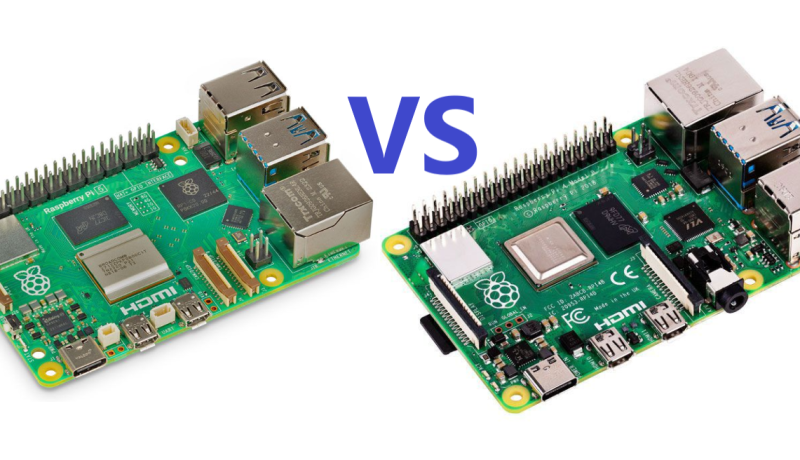
Raspberry Pi 5 vs Raspberry Pi 4! The all-new Raspberry Pi 5 is here, and one of the first questions that comes to mind is: How much better and faster it is from the Raspberry Pi 4? Well, a lot has changed, and there are many features that have been added and improved. It can be easily said that the new Raspberry Pi 5 (RPi 5) is twice as fast as the Raspberry Pi 4 (RPi 4). In this article, we will go over some newly added features, benchmark comparisons, thermals and more.
Raspberry Pi 5 Changes
The Raspberry Pi 5 has the same charming credit card size as previous generations, but a lot has changed while maintaining this size and format. Let’s start with the new CPU on board, the Cortex-A76 CPU clocked at 2.4 GHz, and a new Video Core 7 GPU at 1 GHz. Raspberry Pi claimed that this will offer a considerable leap in performance, which it absolutely does. We’ll dive into this later with some benchmarks.
RAM and More
Another change is the RAM. The new Raspberry Pi 5 rocks DDR4X RAM instead of the DDR4 RAM used before. This enables the RPi 5 to have improved clock speeds with less power consumption, which is a step in the right direction. When we ran some RAM speed tests on the Raspberry Pi 5, we had some remarkable results. The RPi 5 was able to perform close to 30,000 MB writes and reads per second as compared to the Raspberry Pi 4, which could only do 4,000 to 6,000.
Another major improvement is the microSD card slot with support for high-speed SDR104 mode. In our testing, the SD card speeds were twice as fast as the last generation. This is thanks to the new RP1 southbridge developed by Raspberry Pi.
The RPi 5 is the first full-size Raspberry Pi computer that uses silicon developed in-house. The RP1 southbridge provides improved performance in I/O capabilities and functionality that includes doubled USB bandwidth, 2×4-lane MIPI interface support, and a single-lane PCI Express 2.0 interface.
PCI, Cameras, Displays…
One major addition to the Raspberry Pi 5 is the single-lane Gen 2 PCIe connection, which makes the RPi 5 capable of using an NVMe or an M.2 SSD now, with the potential for much faster read and write speeds as well and much-improved performance. This also allows us to connect high-bandwidth peripherals.
One thing that didn’t change is the Wi-Fi and Ethernet: They’re the same as on the last version, and it still works as it should.
The differences, however, are what we’re interested in, so let’s go over everything briefly.
There are two camera/display connectors, so you can have two cameras connected to your Raspberry Pi 5 or a camera and a display, or even two displays.
On board is a new fan connector, which can control the speed of the fan that covers the heat sink on the Raspberry Pi. In addition to the fan connector, we now have a UART connector, a power button to reboot or shutdown, much-improved speeds on the USB 3.0 connectors (reaching up to 5.1 Gbit/s), and an onboard real-time clock (RTC) that can be powered by an external coin cell battery. Table 1 shows the complete list of specifications that differ from the Raspberry Pi 4.

Benchmarks
We did some benchmarking on the Raspberry Pi 5 and the Raspberry Pi4 keeping the setup and hardware the same — so, same build on the SD card, same power supply, and with and without a cooling solution. With the links below, you can take a deep dive into all of the benchmark scores from Geekbench 5. But, for the sake of making things easy, in Figure 1 and 2, you see the overall benchmark scores of the Raspberry Pi 5 and Raspberry Pi 4, which clearly indicate that the Raspberry Pi 5 is two to three times faster than its predecessor in all types of tests.
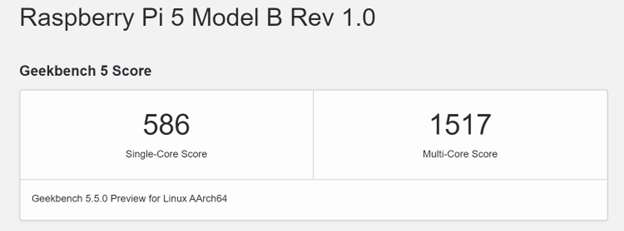
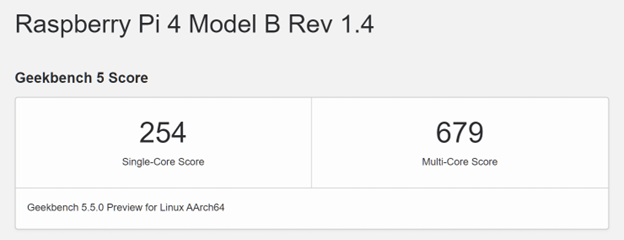
Thermals
As you know, in computing, the faster a CPU becomes in terms of performance, the more power it utilizes, and more power means more heat! We did some thermal imaging of the Raspberry Pi 5 and 4 under both load and idle conditions. We also tested the new active cooler provided by Raspberry Pi, seen in place in Figure 3.
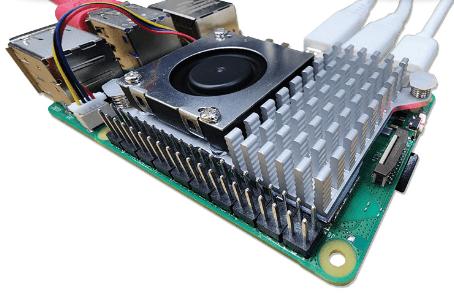
While running benchmarks and some CPU- and GPU-intensive tasks, the RPi 5 almost reached 78°C (at the chip level), without cooling, in the test lab ambient temperature of 23°C. On the other hand, the Raspberry Pi 4 reached a maximum of 71°C (chip-level), without cooling, under the same load — but not with the same performance, of course.
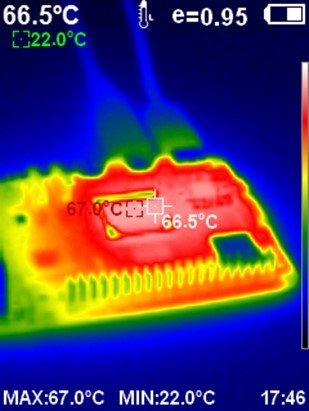
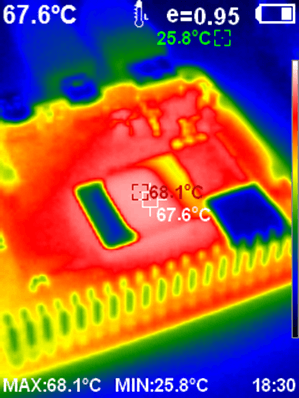

In Figure 4 and Figure 5, thermal images of the Raspberry Pi 5 and Raspberry Pi 4 are shown. These temperatures are quite high, and it is recommended to use the cooling solution provided by Raspberry Pi. In Figure 6, we see the thermal image of the Raspberry Pi 5 with the active cooler installed, and it dropped the chip-level temperature to 58°C — a 20-degree difference with just the cooler! In the future, we’re really looking forward to any new thermal solutions and cases provided by third parties to improve the thermals even more.
Is It for You?
The Raspberry Pi 5 is a game-changer in the single-board computer world. Its impressive hardware upgrades, from its new CPU and GPU to its DDR4X RAM, make it a powerhouse in a credit-card-sized package. You’ll have plenty of peripheral options, from multiple screens to dual cameras to M.2 SSDs. Unfortunately, the USB sockets are not USB-C, but we can hope for that in a future iteration.
While it retains much of the charm and form factor that fans love, it doubles down on performance, making it a compelling offer for both newcomers and Raspberry Pi veterans. We tried to use it as an actual computer, with some normal daily workload, having a 1080p video playing on YouTube alongside some programming in VS Code for the ESP32 (Figure 7). It turns out it performs decently, and it can be used in a scenario where a laptop or computer is not available (use a power bank to power it up). Overall, it is a great addition to the Raspberry Pi family and the price, while higher, is still attractive.
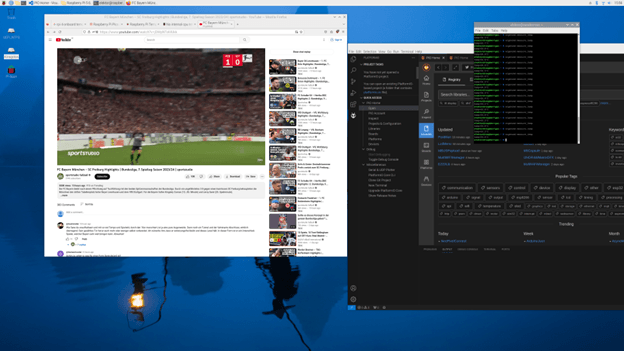
If you’re looking to get your hands on one, the Raspberry Pi 5 promises a whole new level of tinkering, development, and fun.
This article (230635-01) appears in Elektor Mag November/December 2023.
Raspberry Pi 5 vs Raspberry Pi 4: Any Questions?
If you have questions about the Raspberry Pi 5 vs Raspberry Pi 4, feel free to e-mail the author at saad.imtiaz@elektor.com or the editorial team at editor@elektor.com.
Elektor’s RPi 5 Resources
The speedy Raspberry Pi 5, a must-have for pro engineers, makers, and students alike, serves as an ideal foundation. Whether your goal is constructing a desktop computer or deploying a smart robot, Elektor offers a wealth of articles and videos on this versatile board. Check out our Raspberry Pi 5 page.












Discussion (1 comment)
Ajax Lee 11 months ago
Thank you for your insightful coverage of Raspberry Pi 5! I wanted to share an exciting development with you and your audience. We've recently launched a Kickstarter campaign for Arducam Pivistation 5 - an innovative all-in-one camera kit powered by RPi5. It's designed to simplify embedded vision projects and accelerate time-to-market for enthusiasts and professionals alike. You can find more information about our campaign here: https://kck.st/4a4ADEp
Best regards,
Ajax